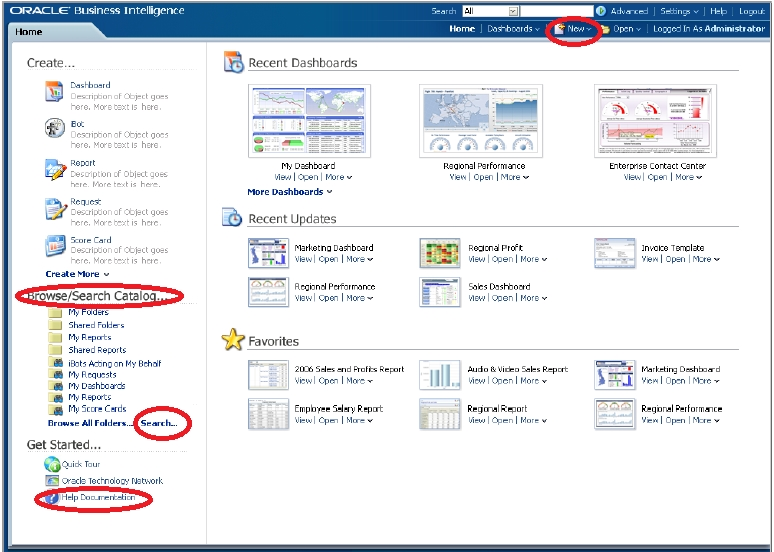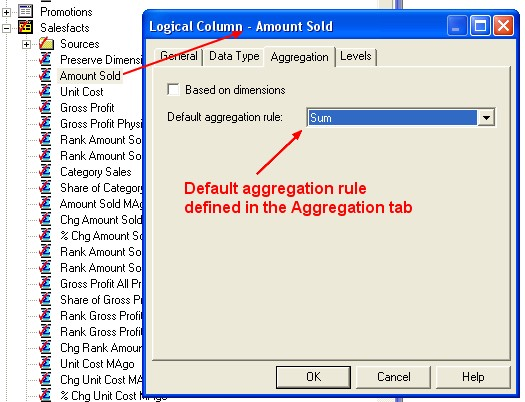Oracle 1z0-591 Exam Practice Questions (P. 4)
- Full Access (120 questions)
- Six months of Premium Access
- Access to one million comments
- Seamless ChatGPT Integration
- Ability to download PDF files
- Anki Flashcard files for revision
- No Captcha & No AdSense
- Advanced Exam Configuration
Question #16
The Oracle BI office plug-in allows you to import the results of an OBI request into which two MS applications?
- AMS Visio
- BMS Excel
- CMS Project
- DMS Word
Correct Answer:
BD
Oracle Business Intelligence Office Plug-In is a Windows application that is an optional feature under the Oracle Business Intelligence Presentation Services. The
Plug-In provides a way to browse the Analytics catalog, select a report, and then drop that report into Microsoft Word or Excel.
Reference: Oracle Business Intelligence Infrastructure Installation and Configuration Guide > Installing Individual Oracle BI Components >Installing Oracle BI
Office Plug-In
BD
Oracle Business Intelligence Office Plug-In is a Windows application that is an optional feature under the Oracle Business Intelligence Presentation Services. The
Plug-In provides a way to browse the Analytics catalog, select a report, and then drop that report into Microsoft Word or Excel.
Reference: Oracle Business Intelligence Infrastructure Installation and Configuration Guide > Installing Individual Oracle BI Components >Installing Oracle BI
Office Plug-In
send
light_mode
delete
Question #17
A user's BI Home page provides one-click access to which three options?
- ACreate new content
- BOracle BI online documentation
- CCatalog search functionality
- DDashboard layout editor
- EBusiness model metadata
Correct Answer:
ABC
See BI Home Page screenshot below:

Note: The BI Home page contains the BI content catalog. Fusion Apps will use OBIEE web catalog to store all shipped reporting and analytics content.
From the BI home page users can browse and view the entire BI content. The BI catalog folder structure will match the Fusion Apps main menu structure. Folder structure would be content driven not technology driven which would enable ease of navigation for fusion Apps users.
Following content will be available under the BI catalog structure:
BI Publisher Reports (regardless of data source)
OTBI reports & dashboards -
OBIA dashboards & scorecards -
Financial Reporting -
Also, users can do some additional actions from the BI Home page like: Access personal and shared reports, View/ edit BI publisher report schedules, Launch BI tools for advanced actions and create new reports with report wizard.
New reports created can be saved in BI catalog and added as embedded content within Fusion applications screens or links added to reporting pane. This enables users to extend the prebuilt embedded analytics within Fusion Applications.
ABC
See BI Home Page screenshot below:

Note: The BI Home page contains the BI content catalog. Fusion Apps will use OBIEE web catalog to store all shipped reporting and analytics content.
From the BI home page users can browse and view the entire BI content. The BI catalog folder structure will match the Fusion Apps main menu structure. Folder structure would be content driven not technology driven which would enable ease of navigation for fusion Apps users.
Following content will be available under the BI catalog structure:
BI Publisher Reports (regardless of data source)
OTBI reports & dashboards -
OBIA dashboards & scorecards -
Financial Reporting -
Also, users can do some additional actions from the BI Home page like: Access personal and shared reports, View/ edit BI publisher report schedules, Launch BI tools for advanced actions and create new reports with report wizard.
New reports created can be saved in BI catalog and added as embedded content within Fusion applications screens or links added to reporting pane. This enables users to extend the prebuilt embedded analytics within Fusion Applications.
send
light_mode
delete
Question #18
A customer needs to have a calculation done prior to aggregating the data. How would you accomplish this?
- ABy creating a derived measure by using the Logical Columns available
- BBy creating a derived measure in the Column Mapping dialog box by using the physical table columns.
- CBy creating a derived measure by using Logic Columns available and changing the aggregation type
- DBy creating a derived metric by using the Expression Builder
- EBy creating a derived metric by using the Calculation Wizard
Correct Answer:
B
Note 1: OBIEE offers two calculation types for measure in the repository: logical physical
You can define calculations in either of the following ways:
* Before the aggregation, in the logical table source.
* After the aggregation, in a logical column derived from two other logical columns. For example: sum(col A) * sum(col B)
Note 2: A measure column is a column unlike the baseline column that has a default aggregation rule defined in the Aggregation tab of the Logical Column dialog in the repository.
Measure columns always calculate the aggregation with which they are defined.
Measures need to be defined in a logical fact. Any column with an aggregation rule is a measure.

B
Note 1: OBIEE offers two calculation types for measure in the repository: logical physical
You can define calculations in either of the following ways:
* Before the aggregation, in the logical table source.
* After the aggregation, in a logical column derived from two other logical columns. For example: sum(col A) * sum(col B)
Note 2: A measure column is a column unlike the baseline column that has a default aggregation rule defined in the Aggregation tab of the Logical Column dialog in the repository.
Measure columns always calculate the aggregation with which they are defined.
Measures need to be defined in a logical fact. Any column with an aggregation rule is a measure.

send
light_mode
delete
Question #19
Which resource identifies the OBIEE Web Catalog (webcat)?
- Ainstanceconfig.xml
- BRCU Schema
- CIdentity Store
- Dnqsconfig.ini
- EAdmin Server
Correct Answer:
CE
C: Oracle Business Intelligence authenticates users and get groups using an Oracle WebLogic Server authentication provider against user information held in an identity store.
Incorrect answers:
A: On 10g, Instanceconfig.xml is THE parameter file of the BI Presentation server. With the advent of 11g, instanceconfig.xml is also the configuration file of
Oracle BI Scheduler -
The instanceconfig.xml file stores the configuration settings that affect Oracle BI Presentation Services.
B: If you want to install the OBIEE Server you have to create some schemas in the database which will keep the OBIEE repository. For working, OBIEE needs some schemas to be created. This work is dome automatically by using rcu (Repository Creation Utility).
In order to create the OBIEE schemas with the RCU, you must have installed an Oracle database (11g).
D: NQSConfig.ini is the main configuration file of Bi Server and contains a lot of parameters.
The file is located in this directory :
11g: ORACLE_INSTANCE/config/OracleBIServerComponent/coreapplication_obisn
All changes made to this file require that you restart the Oracle BI Server Service.
Note: OBIEE 10G/11G - The (Web|Presentation) Catalog (Webcat)
The Web Catalog becomes in 11g the Presentation Catalog.
publisher objects (such as reports and templates).
Each object is composed of two files:
* its own file. For example, an analysis called Analysis 1 would be stored in a file named Analysis1.
* a attributes file. For example, the analysis called Analysis1 would have a corresponding attributes file named Analysis1.atr.
The attributes file contains:
the object's full name,
access control list (ACL),
description,
and so on.
To access an object in the catalog, users must have appropriate ACL entries for that object. All objects in the catalog use ACL entries.
In 11g, the Everyone group has been replaced with the AuthenticatedUser role
The webcatalog is located:
on 11G: ORACLE_INSTANCE/bifoundation/OracleBIPresentationServicesComponent/catalog/
CE
C: Oracle Business Intelligence authenticates users and get groups using an Oracle WebLogic Server authentication provider against user information held in an identity store.
Incorrect answers:
A: On 10g, Instanceconfig.xml is THE parameter file of the BI Presentation server. With the advent of 11g, instanceconfig.xml is also the configuration file of
Oracle BI Scheduler -
The instanceconfig.xml file stores the configuration settings that affect Oracle BI Presentation Services.
B: If you want to install the OBIEE Server you have to create some schemas in the database which will keep the OBIEE repository. For working, OBIEE needs some schemas to be created. This work is dome automatically by using rcu (Repository Creation Utility).
In order to create the OBIEE schemas with the RCU, you must have installed an Oracle database (11g).
D: NQSConfig.ini is the main configuration file of Bi Server and contains a lot of parameters.
The file is located in this directory :
11g: ORACLE_INSTANCE/config/OracleBIServerComponent/coreapplication_obisn
All changes made to this file require that you restart the Oracle BI Server Service.
Note: OBIEE 10G/11G - The (Web|Presentation) Catalog (Webcat)
The Web Catalog becomes in 11g the Presentation Catalog.
publisher objects (such as reports and templates).
Each object is composed of two files:
* its own file. For example, an analysis called Analysis 1 would be stored in a file named Analysis1.
* a attributes file. For example, the analysis called Analysis1 would have a corresponding attributes file named Analysis1.atr.
The attributes file contains:
the object's full name,
access control list (ACL),
description,
and so on.
To access an object in the catalog, users must have appropriate ACL entries for that object. All objects in the catalog use ACL entries.
In 11g, the Everyone group has been replaced with the AuthenticatedUser role
The webcatalog is located:
on 11G: ORACLE_INSTANCE/bifoundation/OracleBIPresentationServicesComponent/catalog/
send
light_mode
delete
Question #20
The ODBC DSN is never used for _______.
- AInitial import of the physical layer metadata on a Windows server
- BQuery execution and data access on a Windows server
- CInitial import of the physical layer metadata, query execution, and data access on a Windows Server
- DChanging passwords
- EComparing RPDs
Correct Answer:
E
You do not use ODBC DSN to compare repositories.
Note: When an ODBC based application connects to a database, it connects to a logical name, the Data Source Name (DSN), which identifies the datasource to which it wants to connect.
Some external repository of configuration information holds the various DSN values that are available, together with the necessary configuration and control information needed by the ODBC driver to establish a connection and manage usage of the data source.
The DSN (data source name) is a data structure that contains the information about a specific data source (database, ), typically used by an ODBC driver to be able to connect to it.
The DSN contains information about the data source such as:
the name,
the directory,
and the driver.
On Windows, the DSN also specifies the ODBC driver to be used to access the database.
E
You do not use ODBC DSN to compare repositories.
Note: When an ODBC based application connects to a database, it connects to a logical name, the Data Source Name (DSN), which identifies the datasource to which it wants to connect.
Some external repository of configuration information holds the various DSN values that are available, together with the necessary configuration and control information needed by the ODBC driver to establish a connection and manage usage of the data source.
The DSN (data source name) is a data structure that contains the information about a specific data source (database, ), typically used by an ODBC driver to be able to connect to it.
The DSN contains information about the data source such as:
the name,
the directory,
and the driver.
On Windows, the DSN also specifies the ODBC driver to be used to access the database.
send
light_mode
delete
All Pages
